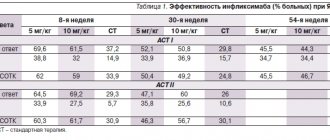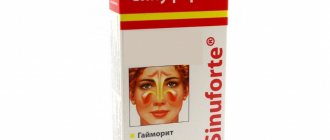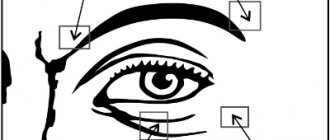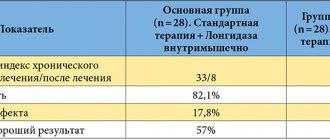Amphotericin b
IV administration
Before each infusion, the exact weight of the patient is determined and the dose of the drug is calculated.
The dose of Amphotericin B is set for each patient individually at the rate of 250 IU/kg body weight. Pre-administer 100 units/kg (to determine individual tolerance). In the future, in the absence of side effects and if necessary, the dose can be gradually increased to 1000 U/kg. The drug is administered every other day or 1-2 times a week (due to the risk of accumulation). The duration of treatment depends on the severity and localization of the process, the duration of the disease and is at least 4-8 weeks to avoid relapses. The total dose of Amphotericin B per course of treatment averages 1.5-2 million units (18-20 infusions). The daily dose of Amphotericin B for children and adolescents
depends on age.
| Daily doses (IU/kg body weight) | ||||
| Age | 1-5 infusion | 6-10 infusion | 11-15 infusion | 16-20 infusion |
| 1-3 years | 75-150 | 100-250 | 150-350 | 175-400 |
| 4-7 years | 100-200 | 150-300 | 175-400 | 200-500 |
| 8-12 years | 125-250 | 175-350 | 200-450 | 225-600 |
| 13-18 years old | 150-300 | 200-400 | 225-500 | 250-700 |
The first course of treatment consists of 20 intravenous drip infusions, which are carried out 2 times a week. After a month's break, it is advisable to repeat the course of treatment. With good tolerability and the absence of side effects, the severity of which is significantly reduced with intermittent course treatment, both courses of treatment (30-40 infusions) are carried out for 5-6 months. In case of intolerance to the drug, daily and course doses of Amphotericin B should be reduced, and the intervals between infusions and breaks between the first and second courses should be increased. Repeated courses of treatment begin with the smallest doses of the drug, gradually increasing them during the treatment process. Inhalation administration
Inhalations are prescribed 1-2 times a day for up to 15-20 minutes in doses of 50,000 units (10 ml) per inhalation, which corresponds to a daily dose of 1000-2000 units/kg of patient body weight.
When using inhalers that work only on inhalation, the single dose is reduced to 25,000 units (5 ml). The duration of treatment is 10-14 days and depends on the severity and duration of the disease. If necessary, a repeat course is prescribed after a 7-10 day break. Rules for the preparation and administration of the drug intravenously
over 3-6 hours at a rate of 20-30 drops/min.
The solution is prepared immediately before use. All preparation and administration procedures should be carried out without exposing the solution to bright light
.
The solvent for Amphotericin B should be 5% glucose solution for injection. If a precipitate appears in the solution, intravenous administration is unacceptable. For intravenous administration, a drug concentration of 100-125 units in 1 ml of solvent is used. Add 5-10 ml of water for injection to the bottle with the drug. Then the mixture is shaken until the powder is completely dissolved. The solution from the bottle is drawn into a sterile syringe using a needle and poured into a bottle with 400 ml of 5% glucose solution. No more than 50,000 units of the drug should be dissolved in the specified amount of solvent. Dose calculation
If the patient’s body weight is 75 kg, then based on the calculation of 250 IU/kg body weight, 250 IU x 75 kg is required, which is 18,750 IU of Amphotericin B. Since 410 ml of a 5% glucose solution should contain 50,000 IU of Amphotericin B, then the required dose of Amphotericin B - 18,750 units - will be contained in 150 ml of solution: 18,750 units x 410 ml ————- = 150 ml 50,000 units Amphotericin B solution for
inhalation
is prepared immediately before use by dissolving the contents of the bottle ( 50,000 units) in 10 ml of water for injection.
For inhalations, inhalers of the AI and PAI-1 types are recommended, but other types can also be used. External use
The ointment is applied to the affected areas of the skin in a thin layer 2-4 times a day.
The course of treatment for candidiasis of skin folds
is 1-3 weeks, for
diaper rash in children
- 1-2 weeks, for
lesions of interdigital spaces and paronychia
- 2-4 weeks.
Amphotericin B, 50 thousand units, lyophilisate for solution for infusion, 10 ml, 1 pc.
IV drip (20–30 drops/min)
for 3–6 hours. The solution is prepared under sterile conditions immediately before use: add 5–10 ml of water for injection to the vial (with a sterile syringe through a puncture of the rubber stopper, having previously treated it with alcohol). For intravenous administration, a concentration of 100–125 units in 1 ml of solvent is used. Next, the mixture is shaken until the powder is completely dissolved, the solution from the bottle is drawn into a sterile syringe using a needle and poured into a bottle with 400 ml of a sterile 5% glucose solution (no more than 50,000 units of antibiotic should be dissolved in the specified amount of solvent). The solution is prepared in a room protected from bright light. If sediment appears, the drug should not be used.
The dose is set individually at the rate of 250 units/kg. Before the start of administration, 100 IU/kg is pre-administered (to determine individual tolerance), with good tolerance, no side effects, and if necessary, the dose is increased to 1000 IU/kg.
Before each administration, the exact weight of the patient is determined and the dose of the drug is calculated (250 IU of the drug per 1 kg of body weight in a patient weighing 75 kg).
The average total dose per course of treatment is 1,500,000–2,000,000 units (18–20 infusions). The drug is administered every other day or 1-2 times a week (risk of accumulation). The duration of treatment is at least 4–8 weeks (to avoid relapses).
Children are prescribed in the following daily doses (IU/kg):
Ages 1–3 years:
from 1 to 5 infusions - 75–150 IU/kg; from 6 to 10 infusions - 100–250 IU/kg; from 11 to 15 infusions - 150–350 IU/kg; from 16 to 20 infusions of 175–400 IU/kg.
Ages 4–7:
from 1 to 5 infusions - 100–200 IU/kg; from 6 to 10 infusions - 150–300 IU/kg; from 11 to 15 infusions - 175–400 IU/kg; from 16 to 20 infusions - 200–500 IU/kg.
Ages 8–12:
from 1 to 5 infusions - 125–250 IU/kg; from 6 to 10 infusions - 175–300 IU/kg; from 11 to 15 infusions - 200–450 IU/kg; from 16 to 20 infusions - 225–600 IU/kg.
Ages 13–18:
from 1 to 5 infusions - 150–300 IU/kg; from 6 to 10 infusions - 200–400 IU/kg; from 11 to 15 infusions - 225–500 IU/kg; from 16 to 20 infusions - 250–700 IU/kg.
The first course of treatment is 20 drip IV infusions 2 times a week, after a break of 1 month the course is repeated. The degree and number of side effects decreases with intermittent course treatment (30–40 infusions over 5–6 months).
In case of intolerance, daily and course doses are reduced and the intervals between drug administration are increased. Repeated courses of treatment begin with smaller doses.
Inhalation.
The solution is prepared immediately before use at the rate of 50,000 units per 10 ml of sterile water for injection. Inhalations are carried out 1–2 times a day for 15–20 minutes at a rate of 1000–2000 units/kg. When using inhalers that work only on inhalation, the single dose is reduced to 5 ml (25,000 units). The course of treatment is 10–14 days, a repeat course after 7–10 days. The solution remaining in the bottle is used for inhalation within 24 hours, provided it is stored in the refrigerator.
Ointment.
Locally, apply a thin layer 1-2 times a day (up to 4 times). The course of treatment is at least 10 days.
Side effects of the drug Amphotericin B
Nausea, vomiting, anorexia, gastralgia, diarrhea, chills, fever, weight loss, headache, electrolyte imbalance (hypokalemia, hypomagnesemia), development of phlebitis at the injection site, rarely - nephrotoxic effect, arrhythmias, hypertension (arterial hypertension), anemia , thrombocytopenia, leukopenia, agranulocytosis, eosinophilia, leukocytosis, blood in the stool or hemorrhagic gastroenteritis, maculopapular rash, pruritus, hearing loss, tinnitus, transient dizziness, blurred vision or diplopia, peripheral neuropathy, convulsions, anaphylactic reactions, acute renal failure.
Amphotericin B – concentrate, lyophilisate, suspension, tablets
IV drip over 2-4 hours, the recommended concentration is 0.1 mg/ml.
Test dose - 1 mg of the drug (base) is diluted in 20-50 ml of 5% dextrose solution and administered intravenously for at least 20-30 minutes under the control of blood pressure, pulse, body temperature every 30 minutes for 2-4 hours .
If well tolerated, the recommended daily dose is 0.25-0.3 mg/kg, depending on the severity of the disease.
In case of hypersensitivity to the drug, diseases of the cardiovascular system, or insufficiency of renal function, treatment begins with low doses - 5-10 mg and, gradually increasing by 5-10 mg/day, is brought to the recommended daily dose - 0.5-0.7 mg/kg.
The selection of therapeutic doses is carried out individually depending on the type and severity of the infection. When using the drug every other day, the dose should not exceed 1.5 mg/kg (to avoid the development of cardiopulmonary failure).
If therapy is interrupted for more than 7 days, it should be resumed from the lowest dose, gradually increasing to the desired level.
Intracavitary instillation: first 5 mg (base) in 10-20 ml of 5% dextrose solution for 3-5 minutes, then 50 mg (base) in 10-20 ml of 5% dextrose solution for 3-5 minutes every day. 8-12 hours after instillation, 20 ml of a 5% N-acetylcysteine solution is administered and continuous slow suction is carried out overnight.
Bladder lavage: 5 mg (base) dissolved in 1 liter of sterile water and irrigated using a three-channel catheter for 5-10 days.
Children: IV, initially 0.25 mg/kg (base) per day in a 5% dextrose solution for 6 hours; taking into account tolerability, the dose is gradually increased (usually by 0.125-0.25 mg/kg every day or every other day) to a maximum dose of 1 mg/kg or 30 mg per 1 sq.m.
Sporotrichosis: course dose 2.5 g, duration of therapy - 9 months.
Aspergillosis: course dose - 3.6 g, duration of treatment - 11 months.
Rhinocerebral phycomycosis: course dose - 3-4 g.
For inhalation - the solution is prepared immediately before use at the rate of 50 thousand units in 10 ml of sterile water for injection. Inhalations are carried out 1-2 times a day, duration - 15-20 minutes. When using inhalers that work only on inhalation, the single dose is reduced to 25 thousand units. The course of treatment is 10-14 days, a second course is after 7-10 days.
Tablets: orally, after meals, adults and children over 14 years old - 200 thousand units 2 times a day; if necessary, the single dose is increased to 500 thousand units. The course of treatment for localized forms of candidiasis is 10-14 days, for widespread forms and deep mycoses - up to 3-4 weeks.
Children are prescribed in single doses: up to 2 years - 25 thousand units, 2-6 years - 100 thousand units, 6-9 years - 150 thousand units, 9-14 years - 200 thousand units, frequency of administration - 2 once a day.
If necessary and there are no side effects, the course of treatment with the drug can be repeated after a 5-7-day break.
Similar drugs:
- Fluconazole Capsule
- Tea tree DN Ointment for external use
- Macmiror Oral tablets
- Celandine grass (Chelidonii majoris herba) Vegetable raw materials
- Pyrithion zinc Substance-powder
- Cinocap Cream for external use
- Forlax Powder for oral solution
- Aurisan Ear drops
- Potassium iodide (Potassium iodide) Substance
- Gino-dactanol Vaginal suppositories
** The Drug Directory is intended for informational purposes only. For more complete information, please refer to the manufacturer's instructions. Do not self-medicate; Before you start using Amphotericin B, you should consult your doctor. EUROLAB is not responsible for the consequences caused by the use of information posted on the portal. Any information on the site does not replace medical advice and cannot serve as a guarantee of the positive effect of the drug.
Are you interested in the drug Amphotericin B? Do you want to know more detailed information or do you need a doctor's examination? Or do you need an inspection? You can make an appointment with a doctor - the Euro lab is always at your service! The best doctors will examine you, advise you, provide the necessary assistance and make a diagnosis. You can also call a doctor at home . Euro lab clinic is open for you around the clock.
** Attention! The information presented in this medication guide is intended for medical professionals and should not be used as a basis for self-medication. The description of the drug Amphotericin B is provided for informational purposes and is not intended for prescribing treatment without the participation of a physician. Patients need to consult a specialist!
If you are interested in any other drugs and medications, their descriptions and instructions for use, information about the composition and form of release, indications for use and side effects, methods of use, prices and reviews of drugs, or you have any other questions and suggestions - write to us, we will definitely try to help you.
Indications for use of the drug Amphotericin B
Amphotericin B IV is prescribed mainly for severe systemic life-threatening fungal infections. Effective against cryptococcosis, North American blastomycosis, disseminated forms of candidiasis, coccidioidomycosis and histoplasmosis, mucormycosis (phycomycosis) caused by strains of the genus Mucor, Rhizopus, Absidia, Entomophthora , as well as Basidiobolus sporotrichosis ( Sporotrichium schenckii ) , aspergillosis ( Aspergillus fumi gatus ). It can also be used for American mucocutaneous leishmaniasis, but is not the drug of choice for primary therapy.
Use of the drug Amphotericin B
Administered by intravenous slow infusion over 6 hours. The initial daily dose should be 0.25 mg/kg body weight, then it is gradually increased to 1 mg/kg depending on the clinical situation. In patients in serious condition, the daily dose can be increased to a maximum of 1.5 mg/kg. Given the long half-life, higher doses can be administered every other day. The duration of treatment can be several months of treatment. A shorter treatment period may lead to insufficient treatment effectiveness or relapse of the disease. If treatment is interrupted for more than 7 days, therapy should be resumed, starting with lower doses of 0.25 mg/kg, gradually increasing them. The recommended concentration of the solution for intravenous infusion is 10 mg/100 ml (100 units/ml).
Pharmacological properties of the drug Amphotericin B
A polyene antifungal antibiotic with a broad spectrum of activity against yeast and yeast-like fungi, including Candida albicans . At concentrations that develop in biological fluids, amphotericin B has a more fungistatic rather than fungicidal effect. Its possible mechanism of action is due to the formation of compounds with sterol rings in the membranes of fungal cells. Crystalline amphotericin is insoluble in water; therefore, to obtain dosage forms for parenteral use, the solubility of the antibiotic is increased by adding sodium deoxycholate, as a result of which this mixture, when dissolved, forms a colloidal solution. The half-life of amphotericin B when administered intravenously is about 24 hours. It has a high (more than 90%) affinity for plasma proteins and is poorly dialyzable. Amphotericin B is slowly excreted by the kidneys, 2–5% of the administered dose is excreted in biologically active form. After cessation of treatment, it is detected in the urine for at least 7 weeks.




